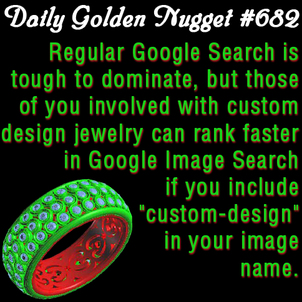 Today's Daily Golden Nugget is for those retail jewelers that create custom design jewelry. If that's you, then take a moment and read and think about this one.
Today's Daily Golden Nugget is for those retail jewelers that create custom design jewelry. If that's you, then take a moment and read and think about this one.A few of the buzz words you frequently hear search engine optimization specialist say include "Googlebot," "spider," and "crawl." Of course there's also the "Bingbot" and the "Yahoobot," as well as a "bot" for every other search engine out there.
That "bot" is not really a robot, but rather a software program that is running on one of Google's or Bing's servers. That program reads you home page, saves all the text from your home page, then it "clicks" your links to jump to the next page on your website. It's this process of jumping from page to page that is known as "spidering" or "crawling" the "world wide web." As you can imagine, those euphemisms evolved simply because the internet is viewed as a very large spider web of sites that link together.
When it comes to website optimization, most people worry about what words they need to put on their website just to be included in the search results. As I said above, Googlebot saves all the text from your home page, and from all the other pages on your website. That text is measured and weighted through Google's secret algorithm to produce the ranking results.
But text is not the only thing that Googlebot saves. There are several variations of Googlebot, including Googlebot-News, Googlebot-Images, Googlebot-Video, and Googlebot-Mobile. Each one of them is designed to crawl the website for specific information.
As a custom design jeweler, it's the Googlebot-Images that I want you to think about, because you can use it to your advantage.
Just like the standard Googlebot, Googlebot-Images will save all the images it finds on the internet. It tries to match up the similar images and group them together. The images are categorized according to their file name, the way they are linked, their ALT text, and the words found on that page.
Google's image search is very sophisticated and it event went through a major upgrade in early 2013. You can search for any phrase and Google Image will return associated images. For example, what do you think Google Images would return when searching for "laughing cat?" That was a random phrase I just pulled out of thin air, and I tested. To my surprise I was presented with a screen filled with cats that had their mouths open. Surprisingly, if you search for "cat with mouth open" the returned cat photos also show cats with open mouths, but this time they actually do NOT look like they are laughing. Try it yourself and you will see the difference.
When Googlebot-Images finds a blog post with the word "laughing" it assumed that the photo is that of a laughing cat. Otherwise, any cat image on a page with the phrase "open mouth" is categorized with the regular "cat with open mouth" photos.
There are a few images that have the word string "laughing-cat" as part of the actual image name. Without referencing the write-up, Googlebot-Images simply assumes that the photos is actually a laughing cat.
Have I beaten this example to death enough? I hope so, because here's how you would use this for your custom design jewelry.
I assume you have a photo gallery of previous custom design jewelry on your website. That gallery should show as many items as you need in order to correctly illustrate your work. I suggest that you also include full detailed write-ups of the design process, including original concept sketches.
Each of the images you put on your custom design page should be named very specifically.
The original sketches and the CAD drawings should include "custom-design" in the name. In fact, you should be more specific and use "custom-design-ring," "custom-design-engagement-ring," or "custom-design-pendant" wherever appropriate.
If you include any photos of the wax mold then you should make sure to name those photos with something like "custom-design-jewelry-wax-mold."
And finally, and this is where I'm changing-up the idea, you should include two versions of your final jewelry photo, perhaps a top and a side photo. One of the photos should have the name in the format "custom-design-engagement-ring" and the other should have the format of "engagement-ring-ideas."
When people search for custom design jewelry of any type they don't always include the phrase "custom design" in their search, many times they use the word "ideas" instead. By naming your images with both of these techniques Googlebot-Images will be able to classify your images for a wide variety of users.
Lastly, I want to tie in an important social aspect of Google Image Search. Google knows who you are, and they know who your friends are, they even know your friends of friends and how everyone connects through Google+. You can seriously boost your impact in Google Image Search if you share your custom design jewelry images to your Google+ account.
Google Image Search will always show matching images from Google+ at the top of the Image Search Results before showing the images found throughout the web. If you want your "Custom Design Services" or "Engagement Ring Ideas" to appear at the top of the list you need to share them to Google+.
Not many jewelers are involved with Google+ Images yet; if you get involved now you can ride the wave.








